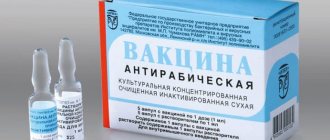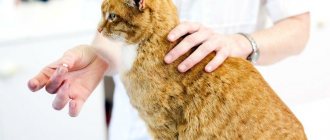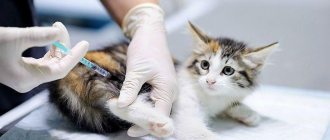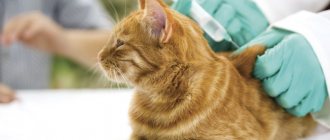Vaccination of pets against rabies is a mandatory procedure in many countries. All dogs are vaccinated; many veterinary clinics even refuse to accept unvaccinated ones. And they often turn a blind eye to the lack of rabies vaccinations in cats. This is because dogs are always at increased risk of infection, but cats are not always at risk. Let's figure out when a rabies vaccination for a cat is mandatory, what kind of rabies injections are available for a cat, who produces the drugs, what consequences can be expected from vaccination, and also consider other issues.
Rabies vaccine for cats - is it necessary?
Rabies vaccination for a cat - which is better?
Rules and Cautions
Complications and consequences after vaccination
Revaccination from A to Z
Does my cat need to be vaccinated against rabies?
To understand whether a domestic cat needs a rabies vaccination, you should first understand how this disease is transmitted.
Rabies is caused by a virus called Rabies virus. This virus is neurotropic, that is, it moves along nerve pathways. Its goal is to damage the central nervous system. It travels along nerve pathways to the brain to shut down essential body functions (breathing and heartbeat). Protecting a cat with a vaccine is only possible before the bite, and not after. An unvaccinated cat bitten by a rabid animal is doomed to death. Read more about this at the link.
In the vast majority of cases, the rabies virus is transmitted through the saliva of an infected animal, which enters the victim’s body through wounds and scratches on the skin and mucous membranes. But the rabies virus is not transmitted through airborne droplets or sexual contact.
A cat can get the virus in the following situations:
- In contact with wild and stray cats, dogs, raccoons, foxes and other mammals. Such contact is possible if the cat is walking on its own, as well as if it runs away from the house or falls out of the window. Cats living in private homes can come into contact with wild animals in their own area, because rabid wild animals often gravitate towards residential buildings - closer to possible victims of the virus.
- Through the bite of a bat, which can fly into a house or apartment. Bats carry a particularly virulent virus, the symptoms of which develop much faster.
- Transmission of the rabies virus from rodents has not been proven, although theoretically this possibility cannot be dismissed. If there are mice and rats in the house, this is a potential threat, although for the most part it is a threat of contracting other infections.
- When eating the brain of an animal infected with rabies, if there are wounds in the mouth. Where a domestic cat can get such a brain is the question. All products must be purchased from certified outlets. And prohibit the cat from feasting on dead animals on the street.
Thus, taking into account the risks, vaccination of cats against rabies is unconditionally indicated in the following cases:
- the cat is on a self-walk;
- in the area where the cat lives, there are many bats that periodically fly into the window;
- the animal lives in a rural area;
- the animal lives in a private house or on the ground floor;
- there is at least the slightest risk of the cat falling out of the window or escaping from the house;
- a dog or a cat that walks outside is kept in an apartment or house together with a domestic cat;
- the cat travels the world with its owners;
- the cat participates in kitten breeding programs and comes into contact with other animals.
Vaccination of an adult cat is possible at any age, except for the very elderly. And vaccination of kittens against rabies under two months of age is prohibited, because This vaccination is quite difficult for the body.
There are also formal requirements, resulting in some animals having to be vaccinated even if they are not at risk. These are exhibition animals that simply will not be allowed into the exhibition without vaccination. These are also cats with which their owners travel abroad: the rules require vaccination against rabies - otherwise the animal will not be released from the country of departure and will not be allowed into the country of destination.
In addition, vaccinations are required for cats living in countries where this is required by law and where the law is unconditionally respected and violations are punishable. Countries with strict requirements in this regard include, in particular, the USA and European countries. There cats are required to be revaccinated every year. In the CIS countries there is a requirement to vaccinate, but most owners do not comply with it, which is very bad.
The conclusion from what has been said is this: all cats need to be vaccinated against rabies, with rare exceptions when the health or age of the animal does not allow this.
Content
- Types of rabies vaccines
- At what age can cats be vaccinated?
- How to prepare an animal for vaccination
- Post-vaccination period
Does a domestic cat need vaccination?
If an animal is walking on the street, a responsible owner will not even think about the need for vaccination. But if a cat lives in an apartment and does not have contact with street animals, is it really necessary? Veterinarians say that it is necessary, since there is still a risk of infection.
In what cases can a pet become infected with rabies?
- The cat runs out into the street through an open door, there is a possibility of contact with a sick animal.
- There are frequent cases of animals jumping out of windows, with the same consequences.
- Mice and rats often live in apartment buildings, and rodents can also be carriers of rabies.
- If owners take their cat with them to the dacha, the likelihood of the pet meeting a sick animal increases significantly.
In addition, your cat will need vaccinations if you take it with you on a trip. In this case, a mark is placed in the veterinary passport no less than 30 days after vaccination. The mark is also required for the animal to participate in exhibitions.
Rabies vaccine for cats: which is best?
Before moving on to the description of specific brands, let's tell a little theory. Vaccines are monovalent (with one component) and polyvalent (with two or more components). Rabies can be vaccinated with both the first and second types of drugs. There is no single point of view as to which is better. Some veterinarians believe that it is better to use a polyvalent one, because in one fell swoop you can get protection from everything and not disturb your body until next year. Others believe that the monovalent vaccine produces more antibodies.
EXPERT COMMENT: US VETERINARIAN KAREN BECKER
Monovalent vaccines are more likely to provide sufficient levels of antibodies than multivalent vaccines. Therefore, if protection against rabies is not needed for show, preference should be given to the monovalent vaccine. Rabies vaccinations should not be given in combination with other vaccines. They should be carried out independently, separated from all vaccinations by at least two weeks.
There are also “dead” and “live” vaccines. “Live” implies the presence of a weakened pathogen in the preparation, which cannot cause a full-fledged disease, but, nevertheless, trains the immune system to the maximum. A “dead” vaccine involves the presence of a killed microorganism, the corpse of which is “showed” to the immune system - and it learns to eliminate the infection from its example.
The rabies vaccine for cats is always “dead”. The price of the consequences of a “live” vaccine introduced into the body, containing a real, albeit weakened, virus, is too high. And although “live” vaccines are considered more effective than “dead” ones, the rabies vaccination is extremely effective even without a live pathogen.
The first rabies vaccine was invented by the French naturalist Louis Pasteur. The same one who invented pasteurization and many other things useful to humanity.
Not all drugs are equally effective and safe. In addition, some countries require specific stamps to enter, and with other vaccines, animals are simply not allowed across the border. This also needs to be taken into account when choosing a drug. Below we will look at the main brands of rabies vaccines for cats.
Nobivac rabies
The vaccine "Nobivak Rabies" (manufactured by Intervet, Holland) is monovalent (rabies only). It can be used in combination with Nobivac Ducat or Nobivac Tricat Trio. These vaccines are adjuvanted (contain an adjuvant). The instructions state that the validity period is 3 years. This is one of the most common vaccines in the post-Soviet countries. At the same time, veterinarians are dissatisfied with the fact that after it few antibodies are produced - slightly above the minimum level.
Price: average 3-5 US dollars.
Defensor 3
The killed antiviral adjuvant vaccine “Defensor 3” (Zoetis, USA) provides immunity for at least 12 months and is considered quite “clean”. Revaccination is carried out once every 3 years or, if necessary, annually. Veterinarians consider this vaccine one of the most effective, because after its administration, much more antibodies are produced.
Price: 2-3 US dollars.
Rabikan
This is a Russian-made vaccine, which is most often administered by clinics in this country. Despite the fact that this is a fairly cheap drug, it leads to the production of large amounts of antibodies. But the problem is that entry abroad often requires vaccines made in Europe or America. If the cat’s owner does not intend to travel abroad with him, you can use Rabikan without any problems.
Price: free (in state clinics in Russia).
Rabisin (Rabizin)
“Dead” antiviral vaccine produced in France (Merial company). The duration of immunity after it is 3 years, however, according to the instructions, revaccination is carried out annually. "Rabizin", like "Nobivak", "Defensor" and other drugs, contains adjuvants - substances that cause an inflammatory reaction at the injection site. This is done to increase the speed of the immune response. However, adjuvanted vaccines do have one serious side effect in cats in some cases. We'll talk about it further.
Price: 3-5 US dollars.
PureVax Feline Rabies
PureVax Feline Rabies (Merial, France) is the first and so far the only non-adjuvanted rabies vaccine for cats in the world. The presence of adjuvants, although it speeds up the body’s response to the vaccine, but in the case of the rabies vaccine, 1 time in 10 thousand vaccinations leads to the development of sarcoma (an aggressive type of cancer). This is written in more detail towards the end of the article. A similar problem is not observed when using an unadjuvanted vaccine. Therefore, those who have the opportunity to order PureVax Feline Rabies should take advantage of it.
However, we hasten to disappoint the residents of the CIS countries. This vaccine is not yet available for sale in Russia, Ukraine, Belarus and many other countries. It is only available in Europe. The Murkotiki portal was informed about this by the representative office of the Merial company and advised to use Rabisin instead, which, although it is a fairly “clean” vaccine, still contains an adjuvant.
If you really want to get PureVax Feline Rabies and if you have the money, you can go to Europe and get vaccinated there at a veterinary clinic. But the problem is that to leave the country you must already have a vaccination, so PureVax Feline Rabies can be given to animals from Russia, Ukraine and Belarus during revaccination, but the first vaccination will still have to be given with an adjuvant drug.
Biofel PCHR (Biofel)
Antiviral adjuvant vaccine produced in the Czech Republic (Bioveta company). The disadvantage of this drug is that it is a rather heavy vaccine: not all animals tolerate it well, plus it contains oils and thiomersal (a mercury-containing compound approved for use) as an adjuvant, which, however, has its own specific characteristics. Here is what the manufacturer writes about precautions for a person who accidentally injects himself with this drug:
The drug contains mineral oil. Even if a small amount of the drug is injected, accidental injection can cause intense swelling, which can lead to ischemic necrosis and loss of the finger. Surgery and possibly incision and irrigation of the injection site are required.
In addition, according to the observation of a veterinarian consulting for the Murkotiki website, fewer antibodies are produced after the drug Biofel than after American drugs.
Rabies vaccine for kittens
The best rabies vaccine for kittens (as well as for adult cats) is PureVax Feline Rabies. However, we remind you that it is only available in Europe. In the absence of this drug, it is better to use “Defensor”, “Rabican” or “Rabizin”.
How to prepare a cat for vaccination
Rabies vaccination is a serious undertaking. In order to properly prepare the animal, you need to perform some steps:
- Deworming. The procedure must be carried out fourteen days before the vaccination day. For this purpose, specialized preparations are used according to the age and weight of the animal.
2 weeks before vaccination, it is recommended to deworm your pet with one of the drugs on the recommendation of a veterinarian - Getting rid of ectoparasites - fleas, ticks, lice eaters, etc. For this, special drops and/or shampoos are used.
- Condition tracking. It is necessary to observe your pet's behavior for several days before vaccination. For example, his activity, appetite, body temperature, stool consistency. If there are deviations from normal behavior, vaccination should be rescheduled.
Rabies vaccination for a cat: preparation and rules
In most cases, post-vaccination immunity after vaccination against rabies in cats is developed within 14-30 days. But in some cases this does not happen. In order for the vaccine to work and not cause harm to the animal, you must follow some rules.
- The vaccine must be administered by a veterinarian. Otherwise, there is a risk of injecting incorrectly and not getting the effect. There is also a risk of purchasing a counterfeit or incorrectly transported vaccine. Clinics buy vaccines from wholesalers who guarantee the necessary conditions for transportation and storage. But a drug purchased in some online store can easily be substandard. Therefore, a self-respecting veterinarian will never inject medication that he took not from his clinic, but from a patient.
- Rabies vaccination is not given to a pregnant cat or a very old cat, kittens under 2 months, sick or weakened animals. At the time of vaccination, the animal must be completely healthy, with normal immunity, and without additional risk factors (such as during pregnancy).
- It is advisable to carry out deworming approximately 10-30 days before vaccination. And although now this requirement is increasingly being neglected, because... There is no evidence that if there are helminths in the body, vaccination will not work (as was previously thought), the opinion of the editors of the Murkotiki portal is that deworming is still necessary. Helminths are a factor that increases the allergic background in the body. Accordingly, there is a greater chance that there will be a negative reaction to the vaccine when the immune system is already ready to react sharply to any attack, which is provoked by infestation.
- The rabies vaccine can be delivered separately from all others, as part of a complex vaccine, or on the same day with a vaccine against other infections using different injections. But the third option is acceptable only if these are vaccines from the same company and the instructions say about their compatibility.
Let's talk separately about the desire of some veterinarians and their clients to excessively check the health of the animal before vaccination. The usual procedure includes a face-to-face examination and temperature measurement. But a number of doctors also recommend taking a blood test, doing an ultrasound of the heart and performing other manipulations. This only makes sense if the animal has recently been ill and you need to find out whether recovery has been achieved or whether it is in remission. If tests show the presence of an acute form of the disease, then vaccination will have to be postponed.
For healthy animals that have not suffered from anything serious in the near future and do not show signs of ill health on the day of vaccination, there is no point in conducting blood tests or other tests. In addition, the blood test takes several days, and during this time the animal can contract an infection and get sick - and the analysis will be useless. Plus, blood sampling is stress, absolutely unnecessary before vaccination. However, if you have any doubts about a particular animal, you should raise your concerns with your veterinarian and get their opinion.
There are also formal requirements necessary for the recognition of rabies vaccination by the relevant authorities issuing veterinary passports and releasing the animal abroad. Among them are:
- administration of the vaccine only by a veterinarian, which is confirmed by his personal signature, seal and sticker of the drug in the veterinary passport;
- a note in the veterinary passport about previous deworming (they may find fault with this, although not necessarily);
- microchipping the animal before vaccination, and not after (otherwise they may not be allowed into some countries);
- if you are traveling abroad, then leaving with a cat is possible no earlier than 30 days have passed since the injection, but no more than a year. Vaccinating a cat against rabies retroactively is not allowed, but some veterinarians accommodate such a client’s request.
How to monitor your cat after vaccination
Immediately after vaccination, it is not recommended to let your pet go for walks; for two weeks the cat should not have contact with its “brothers”, as well as other animals. This precaution is allowed to avoid additional infection that can weaken the body, as well as superinfection from an animal infected with rabies. You should also refrain from swimming.
For several days, monitor the general condition of the cat and its temperature reaction. The above reversible post-vaccination symptoms usually disappear after three to four days. If this does not happen, and the cat has a fever, rashes, or other general phenomena appear, you need to inform your doctor about this.
Where can I get my cat vaccinated against rabies?
You can get your cat vaccinated against rabies at any veterinary clinic. This is one of the most common drugs available everywhere. But there is no choice of brands in small towns: you have to buy what is available.
The cost of rabies vaccination for cats includes the cost of the vaccine itself plus markup and veterinarian fees. As a rule, the veterinarian charges a small amount on top.
In state veterinary hospitals, as well as in mobile points, it is possible to vaccinate a cat against rabies for free. Free rabies vaccination is usually the cheapest drug. But those who do not have money and need protection do not have to choose.
How the disease develops
For the disease to develop, the infection must enter the bloodstream. This occurs through the wound surface of the kitten’s skin, mucous membranes, or through bites from an infected animal.
First stage
The pathogen begins to actively multiply in the body. There are no obvious symptoms right away: until they appear, there is a hidden or incubation period. Visually, at this time, the cat may experience lethargy, refusal to eat, sometimes coughing and fever. The bitten area becomes inflamed, and redness and swelling develop around the damaged skin. These phenomena are accompanied by local itching and pain, causing discomfort to the pet.
Naturally, a cat cannot complain about what bothers it. However, any practicing veterinarian will tell you that this stage is characterized by muscle pain and nausea.
Second stage
Characterized by an increase in symptoms of the disease. The cat begins to behave inappropriately, trying to attack and bite the owner. At times, a sick kitten displays excessive obsession, which is accompanied by elements of aggression. Fear and a desire to run away may appear. Sometimes photophobia is registered: the cat tries to go into the darkness and hide. Symptoms are accompanied by drooling, difficulty swallowing and a number of other body functions.
Third stage
The third and final (terminal) stage consists of the development of convulsions and paralysis. The cat dies as a result of damage to the main centers in the brain that provide vital functions (respiratory, vasomotor, etc.). There are three main forms of manifestation of rabies:
- violent, when the cat shows all the signs of the disease with aggression, irritation, swallowing inedible objects, etc.;
- paralytic, or quiet: the cat seems affectionate and intrusive, but there is profuse salivation, difficulty swallowing, and drooping jaw;
- atypically occurring and most difficult to recognize: the symptoms of brain damage are hidden, and the virus manifests itself in the form of bloody diarrhea, vomiting and exhaustion.
Attention! If your pet exhibits characteristic symptoms and was bitten by a stray animal, consult a doctor immediately! This virus is extremely dangerous not only for the cat, but also for you!
To protect yourself and your pet, there are rabies vaccinations.
How to vaccinate your cat against rabies yourself?
The Murkotiki portal insists that an animal must be vaccinated either in a veterinary clinic, or by calling a good veterinarian to your home. Doing this yourself is not recommended. However, there are situations in which only this option is possible. Then you need to stock up on knowledge that will help you effectively vaccinate an animal.
First, we’ll tell you where to give a rabies injection to a cat. The injection is placed in the following places:
- the withers are the most convenient place for a beginner, but in the case of the rabies vaccine it is undesirable, since if a complication occurs in the form of a sarcoma, it is difficult to remove the tumor from the withers;
- the thigh is the most common place, but a beginner can easily hit a nerve and cause lameness in the animal, but in the event of post-vaccination sarcoma, it is easier to amputate the paw than part of the withers;
- tail - some veterinarians practice placement in this place, because in case of sarcoma, the tail is easiest to cut off; but there is a veterinary opinion that the risk of sarcoma on the tail is even higher, because this part is less mobile - and the drug is absorbed more slowly;
- stomach - recently doctors have begun to practice this place, because the skin from there in the event of a sarcoma is removed relatively easily, but a beginner should not choose this place.
Thus, the two most common places are the withers and the hip. The withers are easier for home administration and more painless for the animal, because there are few nerve endings there. The hip is preferable if the injection is given by a professional veterinarian. Read about the technique of how to give a rabies injection to a cat in another article.
At what age to vaccinate a kitten against rabies is decided depending on the level of risk of infection. The instructions for most drugs say that administration is possible no earlier than 2 months. If the kitten is domestic, does not go outside and there are no animals walking on the street nearby, then it is advisable to vaccinate no earlier than 3 months. Some felinologists and veterinarians advise doing this even later - from 4-6 months. An adult animal can be vaccinated at any time.
In general, we once again emphasize that vaccinating a cat against rabies at home is a bad idea. This should only be done if there are no veterinarians nearby and you can buy genuine vaccine that has been stored properly and that you can quickly transport home. However, this option is unlikely.
In addition, you need to have the skills to give injections. And keep in mind that in any case, a vaccine not supplied by a veterinarian will not be marked in the passport with his signature and seal. This means that it has no legal force (you will not be allowed to go abroad with the animal).
Varieties of vaccine
In the state veterinary clinic, the animal is given a free domestic vaccination. To obtain an imported drug, you must go to a private clinic.
There are 3 types of vaccine:
- Live: it contains weakened types of the virus. Their advantage is that they develop strong and long-lasting immunity. But there is a chance that a real disease will develop. This will happen if the animal is weakened or has low immunity. Therefore, before vaccination, you need to make sure that your pet is healthy.
- Inactivated: The vaccine contains killed viruses. The drug creates weaker immunity, its effect is shorter, but the vaccination takes place without complications.
- Complex: several viruses are present. Very convenient for kittens who receive several vaccinations over a certain period of time.
It is recommended that vaccination be carried out within the walls of a veterinary clinic, where the drugs are stored under proper conditions.
Consequences after rabies vaccination in cats
Negative consequences of vaccination may be present in cases where the animal is allergic to the components of the drug, when the rules for administering the injection are not followed, when the vaccine is of poor quality, when the animal was weakened or sick at the time of vaccination.
Most often, a rabies vaccination for a cat has side effects such as lethargy, drowsiness, and the animal’s aloofness due to poor health, as well as poor appetite. Usually this condition lasts a day or two and begins on the day of the injection. If at first everything is fine with the cat, but after 2-3 days ill health appears, then it is most likely not from the vaccine.
You need to be especially careful if this is your kitten's first rabies vaccination. The body is not yet familiar with the drug, so a reaction may occur immediately. Usually the allergy appears 15-40 minutes after the injection. An allergic reaction to a rabies vaccine in cats can be mild, but there can be consequences up to anaphylactic shock. Therefore, for the first 15-30 minutes you should not leave the veterinarian, but wait. If a reaction occurs, the doctor will eliminate it. This is another reason why you don’t need to vaccinate your kitten yourself.
However, let the readers not be intimidated by all of the above. In fact, the risk of adverse reactions is very low: approximately 50 cases per 10 thousand animals - mostly fever and lethargy, rather than serious allergic reactions.
The main ways cats become infected with rabies
Even if a cat never leaves the house, the possibility of contracting rabies cannot be ruled out. And in this case, a meeting between an unvaccinated cat and an infected animal will be fatal both for the pet itself and, possibly, for its owner.
Most often, rabies infection in cats occurs:
- through a bite;
- when infected saliva gets on damaged skin.
The source of infection for a cat that does not leave the apartment can be a cohabiting and also unvaccinated dog, as well as rabies-infected rodents that have sneaked into the house.
The rabies virus has the ability to infect nerve cells, which leads to death in the infected individual
These accidents are given particular significance by both the absolute lethality of rabies infection and its high infectiousness and danger to all surrounding people and animals. The only reliable protection for a cat is vaccination against rabies.
Video: ways of spreading rabies
Delayed complications
Most often, reactions to the vaccine appear within the first two days, but in some cases the count lasts for months. That is, immediately after the injection the animal feels normal, but after a few months the consequences may appear.
Sarcoma
Post-vaccination sarcomas (cancer tumors) are a very aggressive type of sarcoma. They extensively affect surrounding tissues and metastasize in 20% of cases. Veterinarians usually cut out the affected areas, but this is not a guarantee that sarcomas will not appear again. In some cases, a sick cat must also be irradiated.
This type of sarcoma, scientists suggest, is associated with the administration of adjuvant vaccines that cause a local inflammatory reaction. This is why it is recommended to use unadjuvanted vaccines whenever possible. If an adjuvant vaccine is administered, it is recommended to place it not at the withers. If revaccination is carried out regularly, it is recommended to alternate injection sites.
Granulomas
Subcutaneous administration of the vaccine can lead to the formation of a granuloma - a lump at the injection site. Granulomas do not always go away quickly: sometimes it takes several years. Most often they disappear after a few months. In general, this is not a dangerous consequence.
Autoimmune reactions
Some owners wonder if vaccines can cause autoimmune diseases? Vaccines themselves do not directly cause autoimmune processes, but indirectly they can trigger an autoimmune response in animals genetically predisposed to this, like any other medications, infectious diseases and many other external factors. By the way, this also applies to people.
Can a cat get rabies due to vaccination?
And finally, the most popular consequence of the rabies vaccination, which, in fact, never happens. A cat cannot get rabies as a result of a rabies vaccination, because the drug does not contain a live virus capable of reproduction.
This myth was once partly true, because... Among other things, vaccines with a weakened but live virus were used, which could actually cause the disease. Today, animals are given vaccines made from killed viruses that will no longer cause the development of the disease.
Post-vaccination period
Usually the vaccine is administered intramuscularly, less often - subcutaneously. The standard dose volume is 1 ml. If the preparation is carried out correctly, the animal’s well-being remains normal. It is possible that the cat’s activity may be suppressed for 2-3 days, but this is not critical, and the animal’s condition will improve on its own.
A lump may form at the injection site if the drug was administered subcutaneously. It resolves on its own within a week. After intramuscular injection, swelling does not form.
Negative consequences after vaccination are possible, but only if the animal is not properly prepared and the procedure is carried out without taking into account contraindications. Serious complications are allergic reactions (anaphylactic shock), which cannot be foreseen if a particular drug is used for the first time. Therefore, after the injection, the animal must remain in the clinic under the supervision of a doctor for 20 minutes.
Rabies is a serious and dangerous disease for both the pet and its owner. Therefore, it is necessary to vaccinate your pet, regardless of whether it is walking outside or not. To save time and reduce stress in the animal, it is worth using multicomponent vaccines - they will provide immunity against several diseases, and you will not have to visit the veterinarian often.
Revaccination: how often should you get rabies vaccinations?
When exactly to get a booster shot depends on how long a particular rabies vaccine lasts. And this is written in the instructions for the drug. The validity period can be 1 year, but more often 3 years. The World Health Organization insists that it is better to choose vaccines with a three-year validity period.
However, the legislation of most countries requires annual revaccination. But is it needed?
When should the vaccine be renewed? Annual revaccination is definitely necessary in cases where the animal participates in exhibitions and travels abroad. Otherwise, the cat simply will not be released from the country. Therefore, in this case, the owner has no choice. But, if there is a choice, it is better to revaccinate the animal once every 3 years, and even better - regularly carry out an antibody test, which, however, costs several times more.
EXPERT COMMENT: US VETERINARIAN KAREN BECKER
Most domestic animals are overvaccinated against rabies (this means animals in the USA, because this requirement is strictly observed there - MURKOTIKI), that is, the frequency of vaccination is too frequent. Until vaccination laws are changed to accept titers instead of shots, this will be a problem for many. These vaccines, like all vaccines, have adverse reactions ranging from very mild to severe (including anaphylaxis and death). Therefore, I recommend insisting on the introduction of a vaccine that is effective for 3 years. Research by immunologist Ronald Schultz and veterinarian Jean Dodds shows that the rabies vaccine provides immunity lasting even more than 3 years. This means that pets actually need far fewer vaccinations throughout their lives. And always keep a close eye on the injection site after each vaccination. If you notice a change in the appearance of the skin, such as a bump, irritation or inflammation, contact your veterinarian immediately.
Thus, many eminent veterinarians say that annual revaccination should be replaced by checking antibody titers and, if their level is sufficient, revaccination should be skipped. However, official veterinary medicine does not see a problem with frequent revaccinations.
Revaccination of animals that have once already shown negative effects of the vaccine is a big question. Scientists investigated this issue and came to the conclusion: for such animals, if there is a risk of contracting rabies, it is better for them to undergo serological testing when the timing of revaccination approaches and, if there is a sufficient level of antibodies, not to receive any more vaccine. But if local legislation requires it, then you will have to. Although in post-Soviet countries this requirement is often not observed, no one punishes cat owners for this. But in the USA, where the laws are followed, many animals that do not tolerate the vaccine die when it is administered again. As a result, Delaware even changed its law to allow titer testing instead of revaccination.
If an animal that once reacted poorly to a vaccine still needs to be vaccinated again, sometimes it is enough to change the manufacturer of the drug. Because the consequences are not caused by the main component of the vaccine, but by other components (for example, traces of bovine serum albumin, which is used in the process of cultivating viruses).
In addition, it makes sense to administer an antihistamine before the procedure to animals at increased risk of reacting to the vaccine. This will not affect the immune response, but will help prevent an allergic reaction.
Contraindications to vaccination in cats
Before vaccination, an examination is always carried out; the veterinarian checks for allergies, which serve as a contraindication to vaccination. If you have one of the following contraindications, you must either select another vaccine or refuse vaccination.
Reference! If you purchase a purebred animal and plan to further participate in exhibitions and competitions, or travel abroad, then when purchasing it is important to check not only the passport, but also medical health information.
What is a contraindication:
- Temperature is above normal;
- Allergy, intolerance to one or more elements in the vaccine;
- Period of exacerbation of chronic diseases;
- Presence of infections;
- The period of pregnancy and change of baby teeth.
The most serious contraindication is intolerance to one of the active ingredients in the composition. Then, if possible, another medicine is selected. In other cases, it is necessary to bring the pet’s health back to normal and contact the veterinarians again. If the cat is lethargic immediately after vaccination, then this should alert the owner: over the next 24 hours it is important to show increased attention and monitor the pet’s temperature.
Rabies vaccination schedule
A kitten should be vaccinated against rabies no earlier than 2 months, and preferably 4 months. Some breeders play it safe and start breeding at 6 months. But the problem is that by that time the animal most often has already moved to a new home. Then the problem falls on the shoulders of the new owners, who do not always approach the issue in good faith and may simply ignore the need to vaccinate their pet. Therefore, if you are a breeder, you will have to vaccinate at 3-4 months. If you are the owner of a cat who has not yet had a rabies vaccination, you can wait 6 months if there is no increased risk of infection. If there is even the slightest risk, it is better to immediately contact a veterinarian and carry out all planned procedures.
Let's return to the issue of small kittens. You can start vaccination, for example, at 2.5 months with the usual complex vaccine against major cat infections, and after 2-4 weeks you can give a complex vaccine with a rabies component or a complex vaccine against major infections + rabies vaccine in a separate injection. Or, even better, diagnose rabies 2-4 weeks after the second vaccination against major infections.
After the kitten has been vaccinated, 12 months are counted down - and then a second rabies vaccination is given to an adult cat. Next, the rabies vaccination schedule is once a year, or once every 3 years, or only when the level of antibodies decreases. From a logical point of view, the best option is the third. But legislation, as a rule, requires annual revaccination. Whether to adhere to this schedule or not is a personal choice of the owners: it depends on how strictly the state monitors this.
Due to the fact that many countries, and even within the same country, may have different rules regarding frequency, the International Small Animal Veterinary Association (WSAVA) has initiated the development of “Guidelines for Vaccination of Dogs and Cats” for veterinarians. It is intended to bring reasonable uniformity to the vaccination schedule for dogs and cats in different parts of the world. But for now this is only in plans.
The mechanism of action of rabies vaccines and their varieties
In practice, the body’s defense against various viruses and infections occurs by provoking the production of immunity and antibodies to the virus. And no matter how paradoxical it may sound, the vaccine contains the very virus that causes rabies. True, in minimal safe quantities. The body understands that dangerous foreign bodies are present and begins to produce antibodies. And if an animal becomes infected with real rabies, then their body will be able to independently resist the virus.
2 types of vaccines:
- Live (modified);
- Dead (inactivated).
The difference is that the living have a small fraction of the virus, which with an insignificant probability, but can work. And inactivated ones are completely safe. These are what veterinarians recommend, especially for small kittens.
Reference! There are complex-action drugs that are used to prevent third-party cat diseases.
Can a vaccinated cat get rabies?
Not a single vaccine in the world gives a 100% guarantee that a vaccinated person or animal will not get sick when encountering an infection. However, rabies vaccinations provide reliable protection. However, sometimes vaccination turns out to be ineffective, as a result of which the animal, having encountered the virus, becomes ill. This occurs in cases where the administration of the drug did not cause the proper immune response.
Such cases are tracked using a serological test, which shows the level of antibodies against the virus in the blood. The analysis is taken no earlier than 14 days after the injection. Tests can be taken at a veterinary clinic. They cost 100-150 US dollars. But if there is a financial opportunity and there is a high risk of infection of the animal, it is better to carry out such a test. It may also be required for travel to a number of countries.
Now let’s talk about the reasons why there is no required level of antibodies after vaccination.
Age up to 2 months
Rabies is a rather difficult vaccination, which it is advisable to give to an adult animal. A small kitten may simply not develop immunity, not to mention the high risk of negative consequences.
Period of teeth change
During the period of teeth change (approximately 3-4 to 5-7 months), it is undesirable to inject the vaccine, because this period coincides with the period of reduced immunity of the animal, when it changes from childhood to adult. We will not go into complex terminology, which will seem incomprehensible to many, but will only note that during this period the vaccine may simply not lead to the development of immunity, or, on the contrary, it will lead to the immune system reacting too sharply, up to anaphylactic shock.
The animal is too old
Antigens that have not previously entered the body do not always produce an effective immune response in older animals. Therefore, older cats that are vaccinated against rabies for the first time often do not produce the required amount of antibodies (0.5 IU/ml).
Vaccination given to a sick animal
Vaccination will not stimulate the production of immunity in a sick or weakened animal. In addition, the immune system may respond with an unexpected reaction if it is currently fighting another illness.
Vaccination delivered at the wrong time
If the cat has already been bitten by a rabid animal and the virus has already entered the body, it can be vaccinated just in case. But it won't work. Cats should be vaccinated before they are bitten, not after. If an unvaccinated cat is bitten by a presumably rabid animal, it is quarantined. Rabies injections for cats that have already been bitten are only possible if they have previously been vaccinated. That is, in this way veterinarians try to further increase the level of antibodies in the blood. But no one will vaccinate a bitten cat from scratch. Moreover, private veterinary clinics should not accept animals with suspected rabies. This is done by state veterinarians. If you bring in an animal with symptoms of rabies, a private veterinarian has the right to slam the door in your face.
Wrong dose
The vaccine may not work if the wrong dose is given. But usually there are no problems with this, because... ampoules are designed for one administration.
Spoiled vaccine
Fake and spoiled vaccines don't work. If the vaccine is not kept refrigerated, it will deteriorate and become unusable. It also spoils when frozen.
Wrong combination
Vaccines that are not designed to be combined with each other should not be administered on the same day. If a vaccine is combined with another vaccine, the manufacturer indicates this in the instructions and specifies the name of the second vaccine.
According to a number of veterinarians, a vaccine administered on the same day, even with a compatible drug, can lead to the development of an insufficient level of antibodies. This is why it is recommended to administer the rabies vaccine 2 weeks after or 2 weeks before other vaccinations. True, this opinion is controversial: most doctors do not see a problem in this.
When the vaccine “breaks through”
There are so-called stories when the vaccine “breaks through.” That is, the vaccine was given, immunity was developed, but the animal still got sick when it came into contact with the virus. This is due to the fact that viruses mutate, and the strength of immunity after vaccination decreases over time. Some viruses mutate too quickly, and immunity against some infections disappears too quickly.
If the rabies vaccine fails, this means that immunity was not initially developed for one reason or another (to find out, a serological test had to be performed) or revaccination was not done on time - and the antibody level dropped significantly.
First vaccination: when to do and how to act in subsequent stages
Cases of disease in street animals are periodically recorded in all regions of Russia, so it is very important to carry out the entire course of vaccinations on time and correctly.
A small kitten’s immune system is not ready for such a load. But when he reaches three months, the baby is given the first anti-rabies injection.
Attention! It is not allowed to immunize kittens under 3 months of age. This can negatively affect their health!
Initial immunization occurs in three stages:
- the first - three months or more;
- the second – after 14-21 days;
- upon reaching one year.
For an adult animal, subsequent revaccinations are carried out once a year.
Vaccination for a cat: rules and recommendations
After deworming, the cat is not vaccinated immediately. Before administering the vaccine, it is necessary to examine the animal. His general condition, temperature, tests are important components of the conclusion about the possibility of vaccination. If everything is fine with the cat, the main procedure of administering the vaccine begins. It takes no more than a minute, sometimes even seconds. Often the vaccination will consist of not one, but two injections. As mentioned above, the second injection is the introduction of a rabies preventative.
There are no trifles here: the correct choice of drug, injection skills, consultation on possible complications - these are the main arguments in favor of the fact that vaccination should be done by veterinarians.
Vaccine selection
The correct choice of medication for vaccination is one of the main components of “immune” success. Professionals are guided by the following rules:
- young cats are imported products with a mild effect; adult cats can be vaccinated with a variety of drugs;
- the instructions are required to be studied;
- Compliance with expiration dates is an important condition for ensuring the effectiveness of a medicinal product.
Information about vaccination must be recorded in the veterinary passport. Usually a special sticker is glued into it, which is included with the administered drug.
Self-vaccination
Some people vaccinate their pets themselves. According to veterinarians, this is an additional health risk. Not every cat owner is able to give the injection correctly, much less has sufficient qualifications to select the drug and its dosage. The result is a visit to the veterinary clinic, but not for vaccination, but to eliminate the consequences and complications.
Mandatory vaccinations
It is impossible to force its owner to vaccinate a cat. But there are life circumstances in which vaccination and relevant documents confirming the vaccination of the animal (veterinary passport with marks) are required. First of all, this is traveling abroad.
Without mandatory vaccinations, the cat and its owner simply will not pass border control. So, which vaccinations against which diseases can be considered mandatory:
- Panleukopenia;
- Rabies;
- Calcivirosis;
- Rhinotracheitis.
To travel outside the country, vaccinations must be done no later than 1 month before the departure date.
It’s interesting: even the hotel administration may require a passport with mandatory vaccinations to check in with a pet; it will also come in handy when traveling by rail within our country and the CIS countries, especially in Western Europe.










